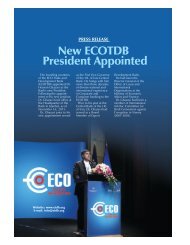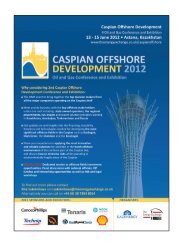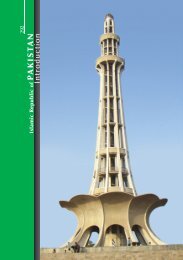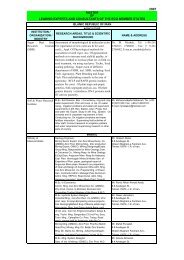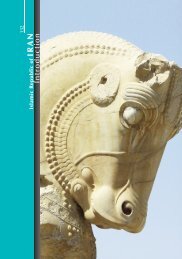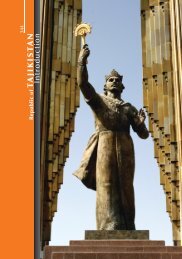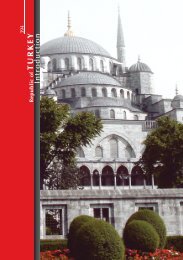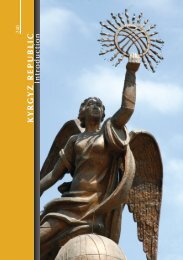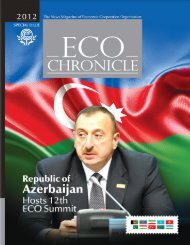ECO-IEST President, Alternative Member to the IPBES Bureau
ECO-IEST President, Alternative Member to the IPBES Bureau
ECO-IEST President, Alternative Member to the IPBES Bureau
You also want an ePaper? Increase the reach of your titles
YUMPU automatically turns print PDFs into web optimized ePapers that Google loves.
Trade &<br />
Investment<br />
north, north-west and east. Toge<strong>the</strong>r <strong>the</strong> ports, road and railways<br />
along NTC handle 95% of external trade and 65% of <strong>to</strong>tal land<br />
freight serving <strong>the</strong> regions of <strong>the</strong> country.The main objective of<br />
<strong>the</strong> NTC initiative is <strong>to</strong> reduce <strong>the</strong> cost of trade and transport<br />
logistics and bring it up <strong>to</strong> international standards in order <strong>to</strong><br />
reduce <strong>the</strong> cost of doing business in Pakistan and ultimately<br />
enhance export competitiveness and country's<br />
industrialization.Pakistan has a road network of around 260,000<br />
kilometers (km) having around 180,000 KM of high type roads<br />
and 80,000 km of low type roads. Total road network has<br />
increased by around 9% in <strong>the</strong> decade up<strong>to</strong> 2009-10. Even <strong>the</strong>n<br />
<strong>the</strong> road density in Pakistan stands at 0.32 which is low when<br />
compared with those of developed economies of UK (1.62) and<br />
Spain (0.68) and some emerging economies such as India (1.00).<br />
Over <strong>the</strong> past ten years, road traffic, both passenger and freight,<br />
has grown significantly faster than <strong>the</strong> national economy.<br />
Currently, it accounts for 91% of national passenger traffic and<br />
96% of freight traffic. NHA (National Highway Authority), a federal<br />
government agency, manages around 12000 km of roads<br />
that carries around 80% of commercial traffic. Over half of <strong>the</strong><br />
national highways network is in poor condition, and <strong>the</strong> road<br />
safety record is poor. The country's truck fleet is mostly made up<br />
of obsolete, underpowered, and polluting vehicles, and trucks<br />
are often grossly overloaded. Truck operating speeds on <strong>the</strong><br />
main corridors are only 40 - 50 kph for container traffic, which<br />
is about half of <strong>the</strong> truck speeds in Europe. For trucks carrying<br />
bulk cargoes, <strong>the</strong> journeys take 3-4 times longer than in Europe<br />
Pakistan Railways' (PR) network consists of <strong>the</strong> main North -<br />
South corridor, connecting <strong>the</strong> Karachi ports <strong>to</strong> <strong>the</strong> primary production<br />
and population centers in <strong>the</strong> north. The track is generally<br />
in good condition with an axle-load of 23 <strong>to</strong>ns and maximum<br />
permitted speeds of 100/110 kph but it needs repair and<br />
rehabilitation at certain points. Over decades, railways level of<br />
service has declined and its share of inland traffic has reduced<br />
from a high of 41% <strong>to</strong> 10% for passenger and 73% <strong>to</strong> 4% for<br />
freight traffic. However, in <strong>the</strong> last nine years (2000?2009),<br />
Pakistan Railways has shown improving trend in both passenger<br />
and traffic registering an average increase of 3.2% and 4.0% per<br />
annum, respectively. However 2009-10 saw a decrease in passenger<br />
traffic as well as freight traffic, which decreased by 13.1%,<br />
over last year's figure. The fall in growth rates for freight traffic<br />
during this period has been attributed <strong>to</strong> <strong>the</strong> less availability of<br />
locomotives for freight traffic because of non procurement of<br />
spares. The productivity of PR's freight services is about 1/3 of<br />
Indian Railways (IR) and half of Thai Railways. In addition, PR<br />
continues <strong>to</strong> cross-subsidize passenger services from freight services,<br />
resulting in non-competitive freight rates over road transport.<br />
As a result, <strong>the</strong> PR has a very low and stagnant market<br />
share, carrying less than 10% of passenger traffic and 5% of<br />
freight. Pakistan Railway is trying <strong>to</strong> bring in private sec<strong>to</strong>r investment<br />
in<strong>to</strong> railway operations by offering certain sections of <strong>the</strong><br />
network for running of passenger and freight trains by paying<br />
track access charges. It has also planned <strong>to</strong> procure around 200<br />
new coaches and induct over 500 new wagons in<strong>to</strong> <strong>the</strong> system.<br />
<strong>ECO</strong> CHRONICLE<br />
45



